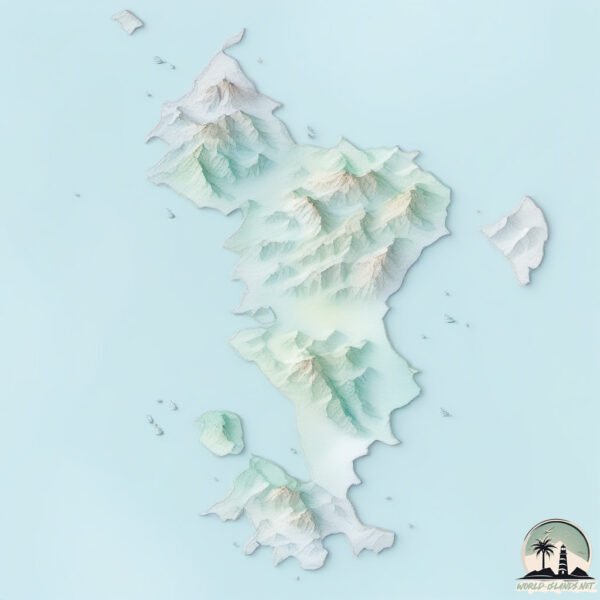Mayotte

Welcome to Mayotte, a Tropical island in the Mozambique Channel, part of the majestic Indian Ocean. This guide offers a comprehensive overview of what makes Mayotte unique – from its geography and climate to its population, infrastructure, and beyond. Dive into the details:
- Geography and Size: Explore the island’s size and location.
- Climate and Weather: Weather patterns and temperature.
- Topography and Nature: Uncover the natural wonders of the island.
- Infrastructure and Travelling: Insights on reaching, staying, and making the most of your visit.
- News and Headlines: Latest News.
Geography and size of Mayotte
Size: 360.3 km²
Coastline: 192.2 km
Ocean: Indian Ocean
Sea: Mozambique Channel
Continent: Africa
Mayotte is a Large Island spanning 360 km² with a coastline of 192 km.
Archipel: Comoros – Located in the Indian Ocean between Madagascar and Mozambique, these volcanic islands are known for their unique blend of African, Arabic, and French influences.
Tectonic Plate: Somalia – A large tectonic plate covering the Horn of Africa and parts of the Indian Ocean, known for the East African Rift where it’s splitting away from the African Plate.
The geographic heart of the island is pinpointed at these coordinates:
Latitude: -12.8234292 / Longitude: 45.14418186
Climate and weather of Mayotte
Climate Zone: Tropical
Climate Details: Tropical Savanna, Wet
Temperature: Hot
Climate Characteristics: Defined by distinct wet and dry seasons with high temperatures year-round. Pronounced rainfall occurs during the wet season, while the dry season is marked by drought.
Topography and nature of Mayotte
Timezone: UTC+03:00
Timezone places: Asia/Riyadh
Max. Elevation: 504 m
Mean Elevation: 136 m
Vegetation: Evergreen Broadleaf Forest
Tree Coverage: 60%
The mean elevation is 136 m. The highest elevation on the island reaches approximately 504 meters above sea level. The island is characterized by Plateau: Elevated flatlands rising sharply above the surrounding area, with a maximum elevation over 500 meters but a mean elevation less than 300 meters, forming unique highland areas on islands.
Dominating Vegetation: Evergreen Broadleaf Forest
Characterized by dense, lush canopies of broadleaf trees that retain their leaves year-round. These forests are typically found in tropical and subtropical regions and are known for their high biodiversity. Mayotte has a tree cover of 60 %.
Vegetation: 9 vegetation zones – Very Highly Diverse Island
Islands in this range are ecological powerhouses, showcasing a wide array of vegetation zones. Each zone, from lush rainforests to arid scrublands, coastal mangroves to mountainous regions, contributes to a complex and interdependent ecosystem. These islands are often hotspots of biodiversity, supporting numerous species and intricate ecological processes.
Infrastructure and Travelling to Mayotte
Does the island have a public airport? no.
There is no public and scheduled airport on Mayotte. The nearest airport is Dzaoudzi Pamandzi International Airport, located 6 km away.
Does the island have a major port? no.
There are no major ports on Mayotte. The closest major port is DZAOUDZI, approximately 1 km away.
The mean population of Mayotte is 643 per km². Mayotte is Densely Populated. The island belongs to France.
The name of the island resonates across different cultures and languages. Here is how it is known around the world: Arabic: مايوت; German: Mayotte; Spanish: Mayotte; French: Mayotte; Portuguese: Mayotte; Russian: Майотта; Chinese: 马约特
Continuing your journey, Dzaoudzi Island is the next notable island, situated merely km away.
Mayotte The African Island Under French Rule



France is classified as Developed region: G7: Group of Seven – Major advanced economies, including Canada, France, Germany, Italy, Japan, the United Kingdom, and the United States. The level of income is High income: OECD.
News – Latest Updates and Headlines from Mayotte
Stay informed with the most recent news and important headlines from Mayotte. Here’s a roundup of the latest developments.
Please note: The data used here has been primarily extracted from satellite readings. Deviations from exact values may occur, particularly regarding the height of elevations and population density. Land area and coastline measurements refer to average values at mean high tide.
